�
Exploratory Programming for the Arts and
Humanities
Nick Montfort
The MIT Press
Cambridge, Massachusetts
London, England
© 2016 Nick Montfort
All rights reserved. No part of this book may be reproduced in any form by any electronic or mechanical means
(including photocopying, recording, or information storage and retrieval) without permission in writing from the
publisher.
This book was set in Stone Sans and Stone Serif by Toppan Best-set Premedia Limited. Printed and bound in the
United States of America.
Library of Congress Cataloging-in-Publication Data
Montfort, Nick, author.
Exploratory programming for the arts and humanities / Montfort, Nick.
Cambridge, MA : The MIT Press, 2016. | Includes bibliographical
references and index.
LCCN 2015038397 | ISBN 9780262034203 (hardcover : alk. paper)
eISBN 9780262331968
LCSH: Computer programming. | Humanities—Data processing.
LCC QA76.6 .M664 2016 | DDC 005.1—dc23 LC record available at http://lccn.loc.gov/2015038397
10 9 8 7 6 5 4 3 2 1
Although this book does not cover 3D graphics, the cover image both evokes exploration and resulted from
programming in an exploratory, artist-driven mode. The image, used with permission, is a screenshot from Stavros
Papadopoulos’s demo for Project Windstorm, which he developed as he started learning JavaScript and WebGL and
which is available at http://zephyrosanemos.com/.
�
Table of Contents
1. Title page
2. Copyright page
3. Acknowledgments
4. Introduction
5. Installation and Setup
6. 1 Modifying a Program
7. 2 Calculating
8. 3 Double, Double
9. 4 Programming Fundamentals
10. 5 Standard Starting Points
11. 6 Text I
12. 7 Text II
13. 8 Image I
14. 9 Image II
15. 10 Text III
16. 11 Statistics and Visualization
17. 12 Animation
18. 13 Sound
19. 14 Interaction
20. 15 Onward
21. Appendix A: Why Program?
22. Appendix B: Contexts for Learning
23. Glossary
24. References
25. Index
�
Acknowledgments
First, my thanks go to everyone who has taught and encouraged exploratory programming,
from at least the 1960s through today.
Many people discussed the concept of this book with me at different stages of the
project. Some of these informal conversations were quite important to the final direction I
took with the text, for instance, because I learned than many senior artists and researchers
were interested in learning programming using a book of this sort. In response, I
developed a book that could be used in a class or by independent learners.
the opportunity
to
in
the Boston area (at MIT). I also had
I greatly appreciate the opportunity to do daylong and multiday workshops on
exploratory programming in New York (at NYU), in Mexico City (at UAM-Cuajimalpa),
and
teach an
undergraduate/graduate course based directly on a late draft of the book in New York, at
the New School, thanks to Anne Balsamo. My New School students were a great help to
me as I worked to complete this book. I’ve benefited from many experiences teaching
programming, and I also wish to thank my students in semester-long courses at MIT, the
University of Pennsylvania, and the University of Baltimore. At the University of
Pennsylvania, I’m grateful that I learned at least the basics about statistical research in
computer science from Michael Kearns and also learned about natural language
processing from Mitch Marcus and the researchers at the Institute for Research in
Cognitive Science.
My thanks go to several who reviewed the full text of this book. Erik Stayton went
through the full manuscript, commenting on it and correcting it, and also completed all the
exercises. Patsy Baudoin provided detailed comments on a full draft of the manuscript.
My inestimable spouse, Flourish Klink, also did, and supported me in many other ways as
I worked on this project.
My thanks also go to those at the New York gallery Babycastles, where a good bit of
work on this book was done, and particularly to those who helped out there by reading and
commenting on parts of the manuscript as I completed it: Del, Emi, Frank, Justin, Lauren,
Lee, Nitzan, Patrick, Stephanie, and Todd. As I was in the last stages of work on this book,
I got to teach a two-day course based on some of it for the School for Poetic Computation
in New York City, and I thank my students and those who ran the school’s summer session
for this opportunity. I owe some important specifics in this book to conversations with
Benjamin Mako Hill, Warren Sack, and Allison Parrish.
The MIT Press of course arranged for anonymous reviewers to consider both the
proposal and the manuscript closely; I am grateful to these reviewers for their support of
the project and for their valuable comments and suggestions. At the Press, I also
particularly would like to thank Doug Sery, who has discussed, worked on, and supported
my book projects for about a decade and a half now. I can’t imagine having explored as
many issues in digital media and creative computing, in the same breath and depth,
without his backing over the years. I also appreciate the work MIT Press editor Kathy
Caruso (who has worked on three previous books of mine) did to improve the manuscript
and ready the book for publication. Any errors in the published text, after all of these
contributions and work from others, are of course my responsibility.
欢迎加入非盈利Python编程学习交流QQ群783462347,群里免费提供500+本Python书籍!�
The text of appendix A, along with a few paragraphs from the introduction, is also
being published in only slightly different form in A New Companion to Digital
Humanities, edited by Susan Schreibman, Ray Siemens, and John Unsworth (Hoboken,
NJ: John Wiley & Sons, 2016), as “Exploratory Programming in Digital Humanities
Pedagogy and Research.”
欢迎加入非盈利Python编程学习交流QQ群783462347,群里免费提供500+本Python书籍!�
Introduction
This is a book about how to think with computation and how to understand computation as
part of culture. Programming is introduced as a way to iteratively design both artworks
and humanities projects, in a process that enables the programmer to discover, in the
process of programming, the ultimate direction that the project will take. My aim is to
explain enough about programming to allow a new programmer to explore and inquire
with computation, and to help such a person go on to learn more about programming
while pursuing projects in the arts and humanities.
I developed this book, in part, for use in college and university courses, as a textbook. I
was glad to have the opportunity to use a draft version of it in an graduate/undergraduate
course in New York City at the New School. I also worked to develop a book that will be
useful to learners, working either individually or alone, who are not taking formal courses.
I provide suggestions for teaching this book, and for learning from it in a class, in
“Appendix B: Contexts for Learning,” which also includes some suggestions for those
pursuing programming less formally.
To some, programming is associated with expertise, professional status, and esoteric
technical difficulty. I don’t think programming needs to be intimidating, any more than the
terms writing or sketching do. These are simply the conventional words for different
activities—creative activities that are also methods for inquiry.
You don’t need any background in programming to learn from this book, and courses
based on this book do not need to require any background. If you are already comfortable
programming, you may still benefit from reading Exploratory Programming for the Arts
and Humanities, particularly if your work as a programmer has been instrumental and you
have mainly worked to implement specifications and solve specific problems. I assume,
though, that a reader has no previous programming experience.
In my approach to programming, I seek to show its exploratory potential—its facility
for sketching, brainstorming, and inquiring about important topics. My discussions,
exercises, and explanations of how programming works also include some significant
consideration of how computation and programming are culturally situated. This means
how programming relates to the manipulation of media of different sorts and, more
broadly, to the methods and questions of the arts and humanities.
This book was written and designed to be read alongside a computer, allowing the
reader to program while progressing through the book. The book is really meant to be part
of a human-book-computer system, one that is set up to help the human learn. After
reading this introductory material, I consider it essential to use this book while
programming.
I ask at times that readers follow along and simply type code in directly from the book,
in part to gain familiarity and comfort with practical aspects of inputting and running
programs. At other times, readers are asked to try out some modifications (some of them
small-scale, some more significant) of existing programs. Some carefully chosen
exercises, initially on a small scale and then more substantial, are provided. In some of
these cases, a specification is given for a program, describing how it is to work in a
欢迎加入非盈利Python编程学习交流QQ群783462347,群里免费提供500+本Python书籍!�
particular way. Although doing such exercises is not an exploratory way to program, they
are included to provide a wider range of programming experiences and foster familiarity
with code and computing. Particularly when learning the fundamentals of programming,
such exercises are important. For these reasons, these exercises are concentrated in the
middle of the book, in chapters 5 and 6.
Finally, throughout the book “free projects” are described. These are intentionally
underspecified exercises, leaving room for readers to determine their own directions and
to write different sorts of programs. In these projects, the final program is to be arrived at
not simply by implementing a fixed specification, but by undertaking some amount of
exploration through programming.
In some books and courses on programming, readers learn about different sorting
algorithms and about how these algorithms have different complexities in space and in
time. These are fine topics, and necessary when building a deep foundation for those who
will go on to understand the science of computation very thoroughly. If you know already
that you are seeking understanding and skills equivalent to a bachelor’s degree in
computer science, or that you actually wish to pursue such a degree, you should probably
find a more appropriate book or take a course that covers that material. Furthermore, if
your interest is only in learning how to program, and not in the use of programming for
exploration or in making a connection between computation and culture, there are good
shorter books worth considering, such as Chris Pine’s Learn to Program, second edition,
which uses Ruby to teach general programming principles. Similarly, if you really don’t
wish to learn to program, but you are interested in how computation relates to issues in the
arts and humanities, there are plenty of books and articles focused on these relationships.
One of them is a book I wrote with nine coauthors, 10 PRINT CHR$(205.5+RND(1)); :
GOTO 10, which studies a one-line BASIC program in great depth, considering many of
its cultural contexts.
It’s fair at this point to be clear about what Exploratory Programming for the Arts and
Humanities is not: It is not an attempt to have readers completely understand any one
particular programming language. It is not meant to show people how to professionally
produce products or complete the typical “deliverables” of software engineering. It is, as
stated earlier, not meant to provide a complete first course for those who will continue to
do significant study of computation itself. This book is certainly compatible with
computer science education, but it is an attempt to lay a different foundation, one for
artistic and humanistic inquiry with computing.
This is a book about how to think with computation—specifically, how to think about
questions in the arts and humanities, and how to do so by means of programming. I
believe this book will supply a solid enough foundation for new programmers that those
who read it, and who follow along and do the exercises, will be able to pursue a greater
ability in specific programming languages, learn about essential matters of collaborating
on software projects, and understand that computation significantly engages with culture
and with intellectual concerns in the arts and humanities. I also hope that working through
this book will reveal the potential of programming as a means of inquiry and art-making—
at least, that it will reveal enough of that potential. As long as it does, readers will likely
be eager to continue their programming, and their inquiry, after they are done with the
欢迎加入非盈利Python编程学习交流QQ群783462347,群里免费提供500+本Python书籍!�
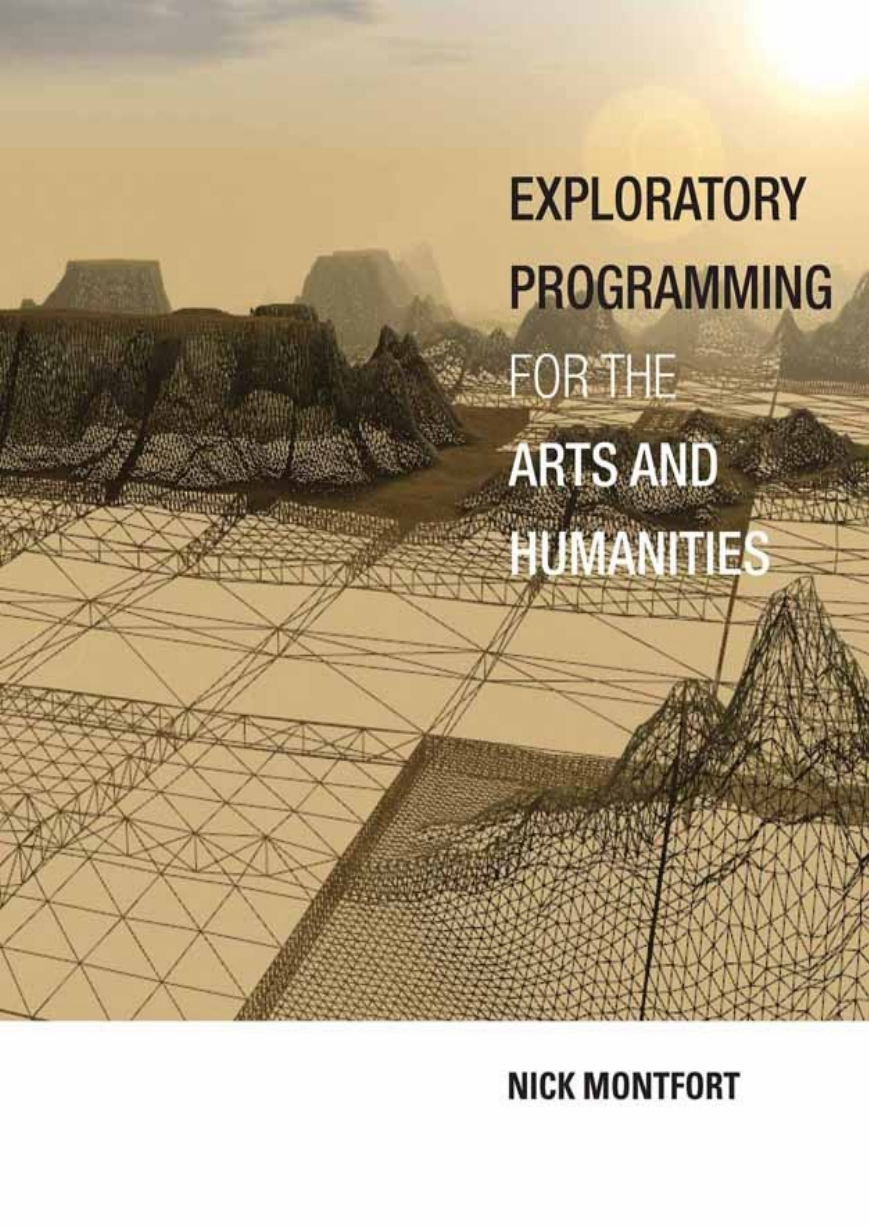
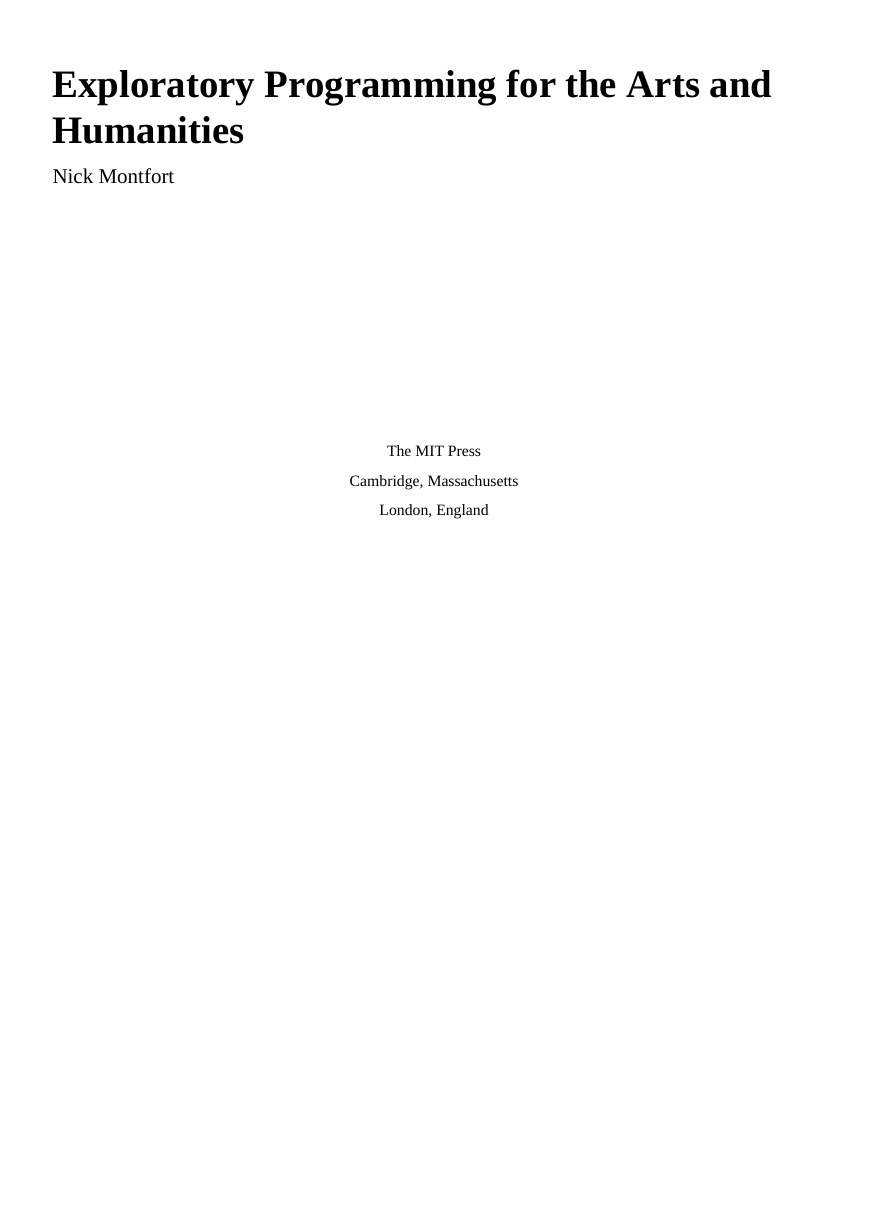

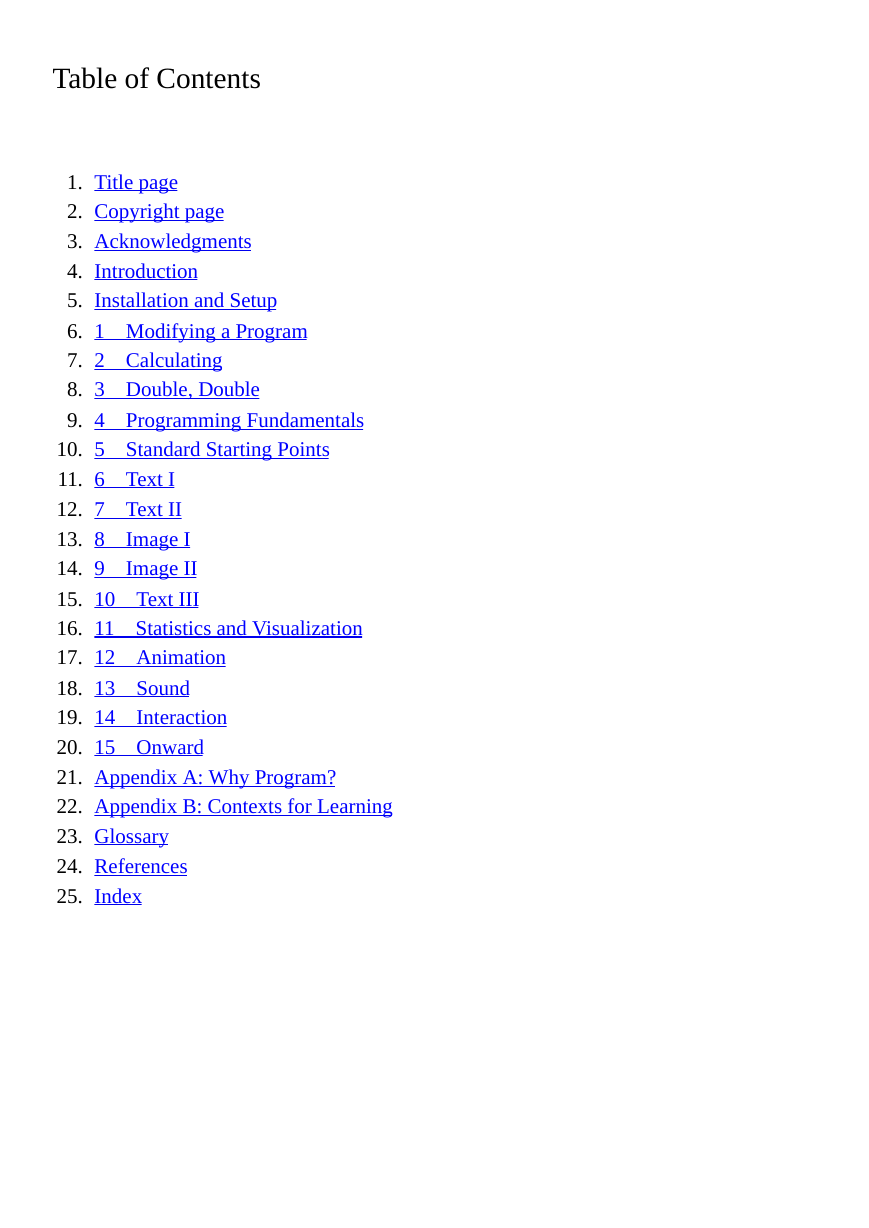
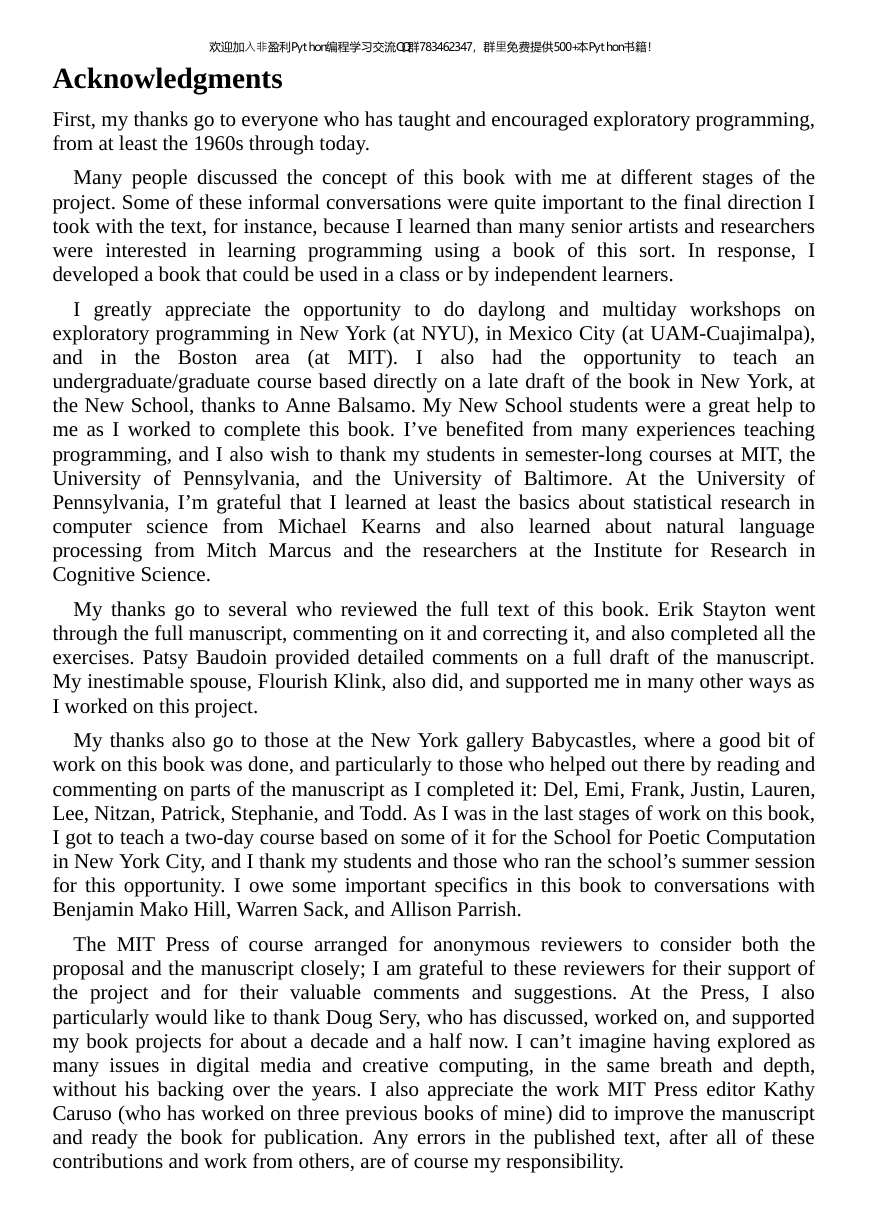
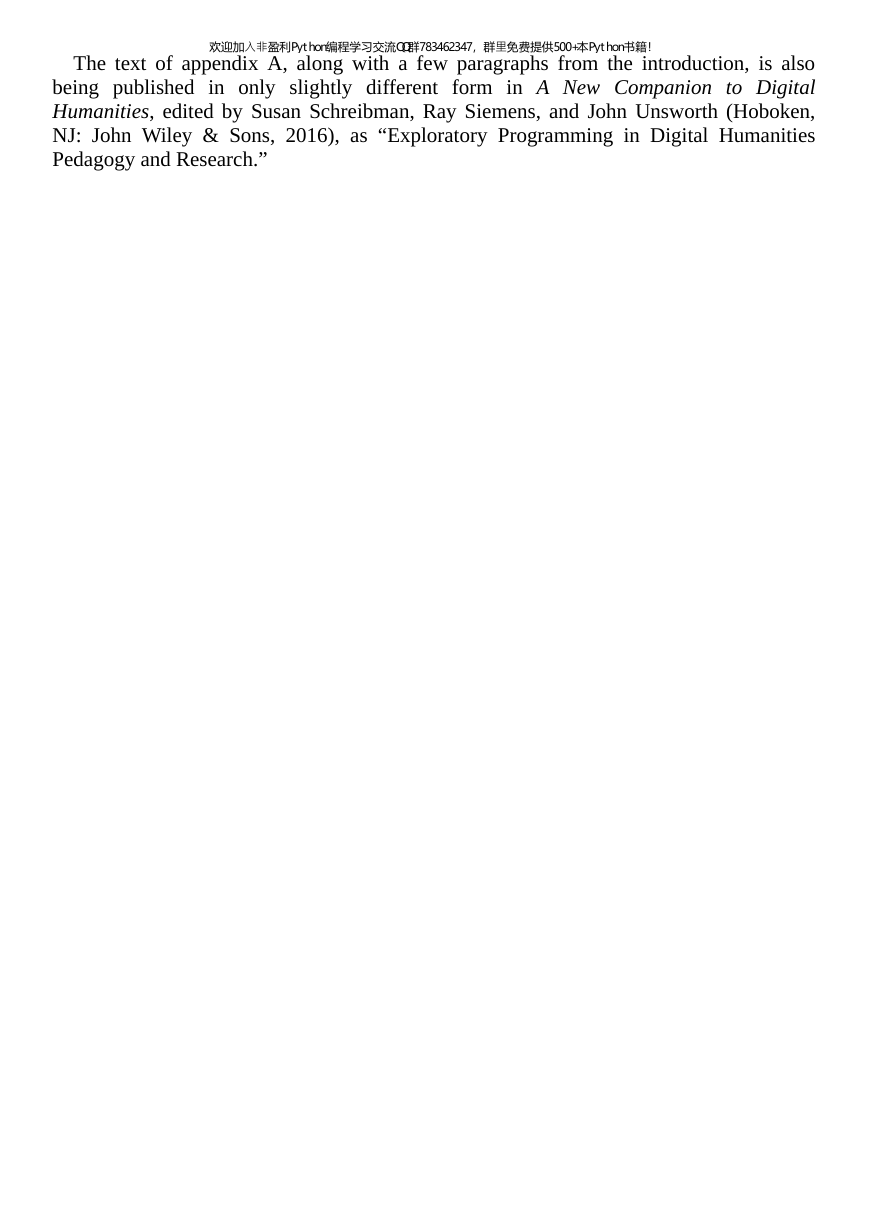
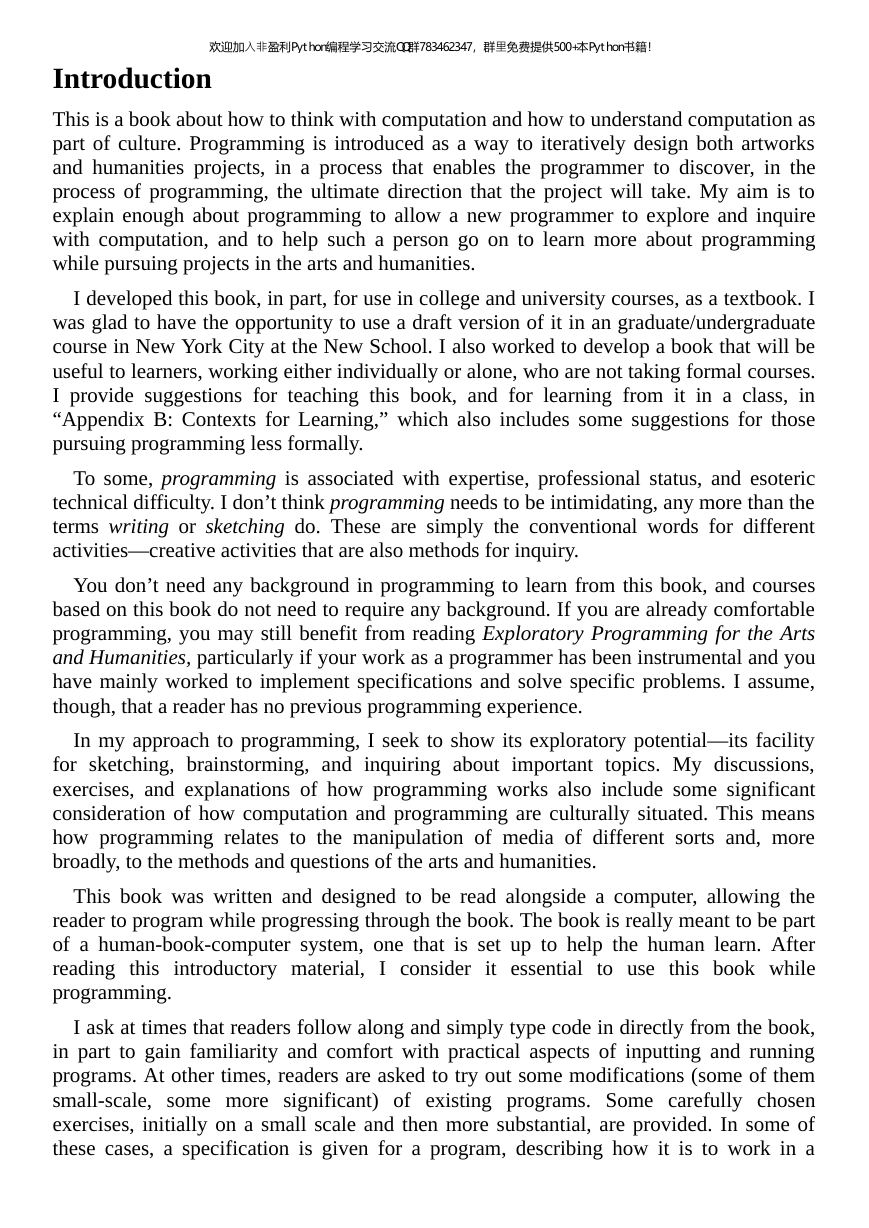
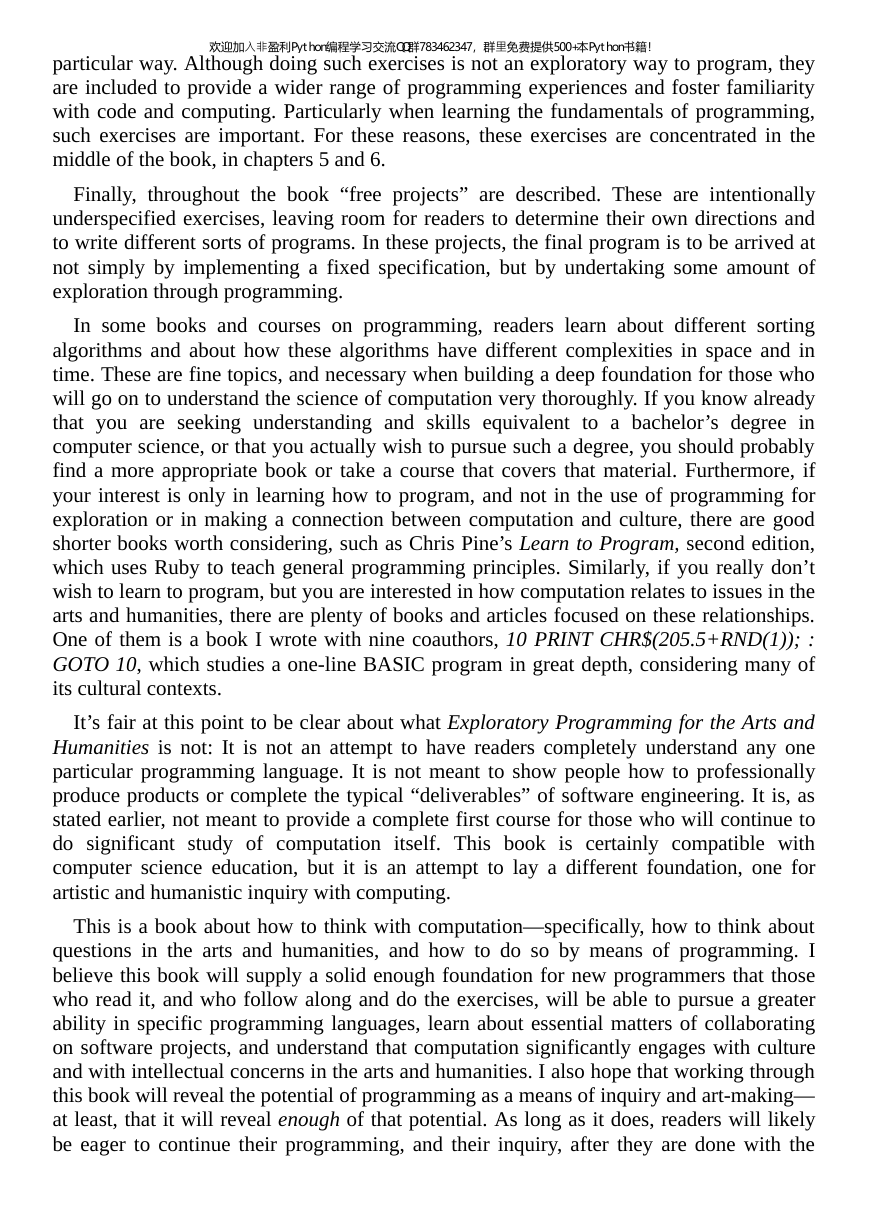








 2023年江西萍乡中考道德与法治真题及答案.doc
2023年江西萍乡中考道德与法治真题及答案.doc 2012年重庆南川中考生物真题及答案.doc
2012年重庆南川中考生物真题及答案.doc 2013年江西师范大学地理学综合及文艺理论基础考研真题.doc
2013年江西师范大学地理学综合及文艺理论基础考研真题.doc 2020年四川甘孜小升初语文真题及答案I卷.doc
2020年四川甘孜小升初语文真题及答案I卷.doc 2020年注册岩土工程师专业基础考试真题及答案.doc
2020年注册岩土工程师专业基础考试真题及答案.doc 2023-2024学年福建省厦门市九年级上学期数学月考试题及答案.doc
2023-2024学年福建省厦门市九年级上学期数学月考试题及答案.doc 2021-2022学年辽宁省沈阳市大东区九年级上学期语文期末试题及答案.doc
2021-2022学年辽宁省沈阳市大东区九年级上学期语文期末试题及答案.doc 2022-2023学年北京东城区初三第一学期物理期末试卷及答案.doc
2022-2023学年北京东城区初三第一学期物理期末试卷及答案.doc 2018上半年江西教师资格初中地理学科知识与教学能力真题及答案.doc
2018上半年江西教师资格初中地理学科知识与教学能力真题及答案.doc 2012年河北国家公务员申论考试真题及答案-省级.doc
2012年河北国家公务员申论考试真题及答案-省级.doc 2020-2021学年江苏省扬州市江都区邵樊片九年级上学期数学第一次质量检测试题及答案.doc
2020-2021学年江苏省扬州市江都区邵樊片九年级上学期数学第一次质量检测试题及答案.doc 2022下半年黑龙江教师资格证中学综合素质真题及答案.doc
2022下半年黑龙江教师资格证中学综合素质真题及答案.doc